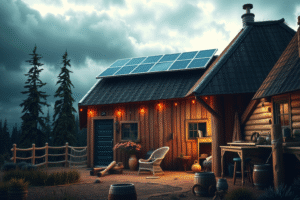With energy prices rising and concern growing about our impact on the environment, reducing our energy usage and carbon footprint at home is becoming an increasingly important issue. However, it’s not always clear where to start. Naturally, many people think of turning down the thermostat and unplugging their devices, but there are also some unexpected and innovative ways to make your home more energy efficient. By making small changes and being smart about your purchases, you can make a big difference to both your bills and your impact on the environment.
1. Control Your Heating and Cooling
One of the biggest energy costs in many homes is heating and cooling. While some homes may benefit from an energy-efficient heating and cooling system, most of us can make big energy savings by simply using our heating and cooling systems more efficiently. Make sure your home is well-insulated and seal air leaks to keep air conditioning in and hot air out. Use curtains to keep the sun out and open windows and doors when the temperature is just right.
2. Invest in Energy-Efficient Appliances
From your washing machine to your refrigerator, appliances are getting more energy efficient all the time. When it comes time to replace an appliance, make sure you look for the Energy Star label, which indicates the most energy-efficient appliances. Even if you’re not ready to invest in a new appliance, unplugging and turning off unnecessary appliances can still make a big difference. Look for outlets and surge protectors with a “smart” feature, which will turn off electricity to connected devices when they’re not in use.
3. Be Smart About Lighting
Lighting is something many people overlook when trying to save energy. Turning off lights when they’re not needed is the first step, but there are other ways to make lighting more efficient. Use LED or CFL bulbs, which use much less energy than traditional bulbs. Making sure that your bulbs are clean and free of dust also helps to make sure that they stay efficient. Finally, you can use motion sensors to automatically turn off lights when no one is in the room.
4. Be Smart About Hot Water
Heating water can be one of the biggest energy costs in a home. Use a water heater blanket and set the thermostat to a lower temperature to save energy. Try to run your dishwasher only when it is full and make sure to use the energy-saving setting on your washing machine. If you’re taking a bath, try to use less water and take shorter showers. Finally, consider switching to a tankless water heater, which heats water on demand and can be much more efficient.
5. Use Electronics Wisely
Unplugging electronics is an easy way to save energy, and you can even buy power strips with an auto-shut off feature for added convenience. Make sure to adjust the settings on your computer and other electronics to the energy-saving setting. Charge your devices less frequently, and don’t forget to turn off and unplug your devices when you go on vacation. Finally, consider purchasing ENERGY-STAR-rated electronics, which use less energy than others.
6. Use Fans to Circulate Air
Not only can ceiling fans keep you cool in the summer, they can also be useful in the winter. By running a fan in the clockwise direction, you can help to circulate warm air from the ceiling to the floor, which can help to raise the temperature of a room by a few degrees. Make sure to adjust the speed of the fan to the most efficient setting.
7. Use Insulated Windows and Doors
It’s estimated that 25 to 30% of a home’s energy use is lost through poorly-insulated windows and doors. Make sure that your windows and doors are well-sealed so that no heat or air conditioning is leaking out. For an added boost, consider using energy-efficient windows and doors, which can help to keep your home comfortable and use less energy.
8. Upgrade Your Insulation
One of the best things you can do to save energy is to upgrade your insulating material. Good insulation can help to trap heat in the winter and keep it out in the summer, meaning you’ll need less energy to keep your home comfortable. In addition to the walls and ceilings, make sure to insulate your attic and other areas where heat can enter and escape.
9. Check for Leaks
It may seem like a small detail, but leaky faucets, pipes, and air ducts can waste a lot of energy. Closely inspect your home for any signs of leaks. Use weatherstripping and caulk to seal any gaps around windows and doors, and make sure that your air ducts are free of holes and leaks. For faucets and pipes, make sure to get any leak fixed as soon as possible.
10. Make Smart Purchases
Finally, make sure to do your research and make smart purchases that will help you to save energy. From household cleaners to light bulbs, look for products that are labeled as “green” or “eco-friendly.” Many products now have labels that indicate how much energy is used to produce them and if they are recyclable, so make sure to read the label before making a purchase.
By making a few simple changes to your home, you can make a big difference when it comes to energy efficiency. Try to implement one or two of the above changes right now, and see what a difference it can make to your energy bills and carbon footprint. Which of the above tips do you plan to try out? Do you have any other energy-saving tips to share? Comment below and let us know!



